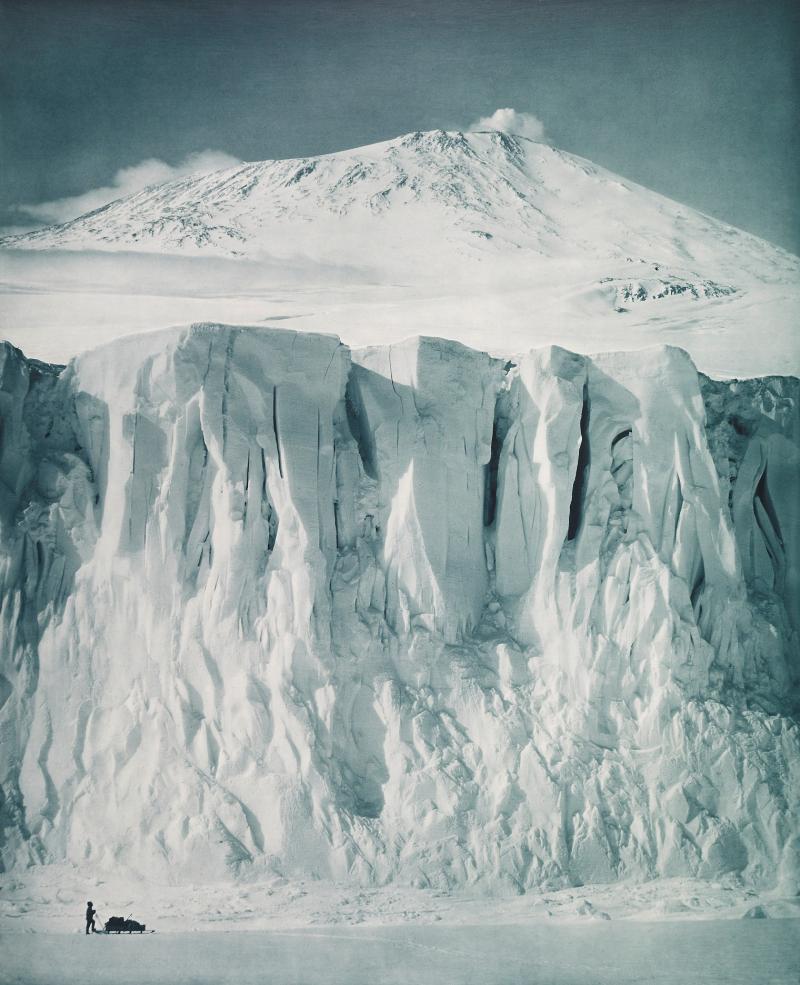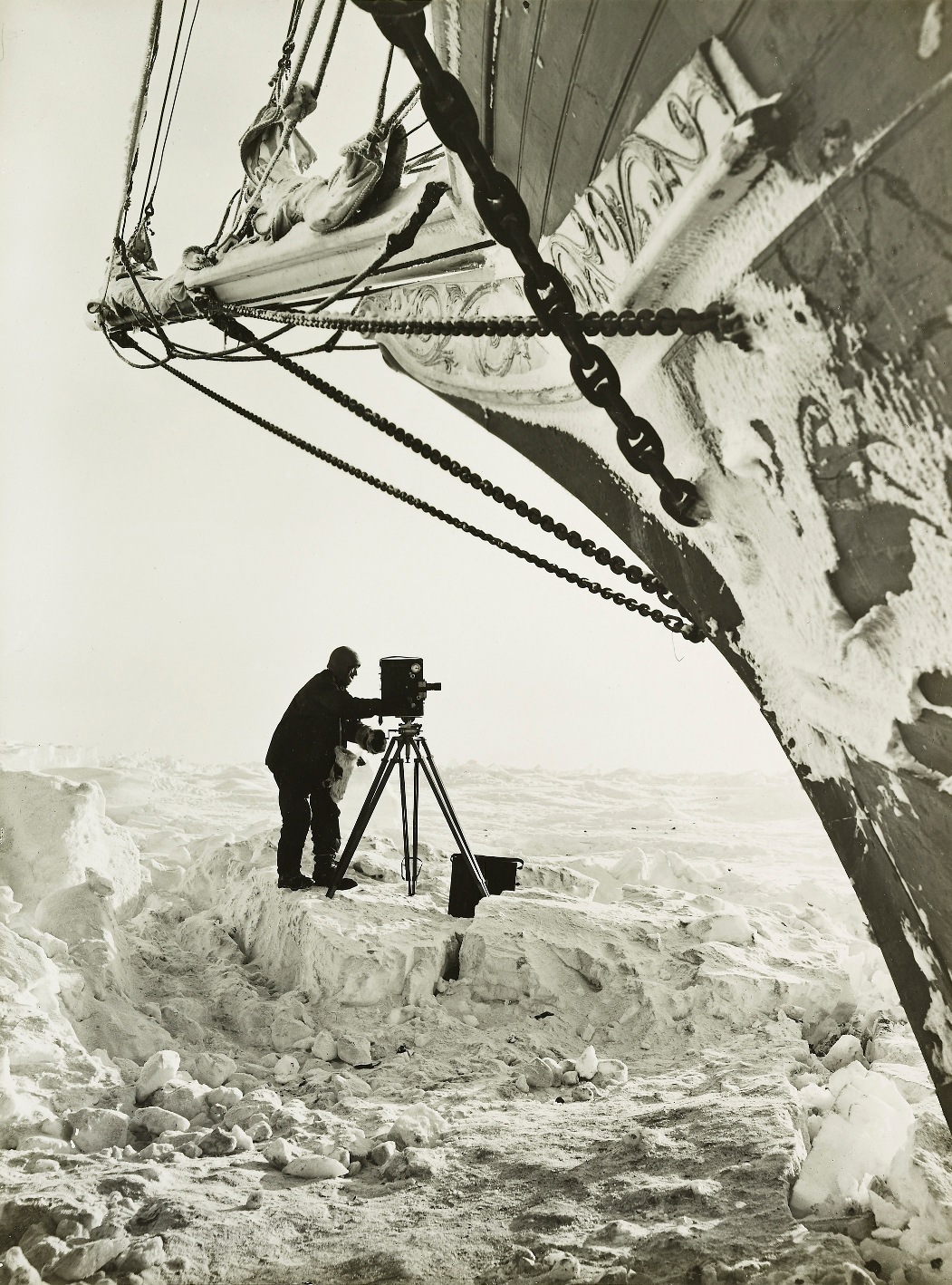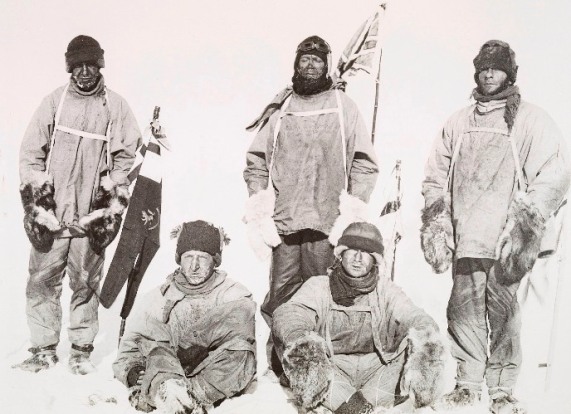The Heart of the Great Alone: Scott, Shackleton and Antarctic Photography, Queen's Gallery | reviews, news & interviews
The Heart of the Great Alone: Scott, Shackleton and Antarctic Photography, Queen's Gallery
The Heart of the Great Alone: Scott, Shackleton and Antarctic Photography, Queen's Gallery
Herbert Ponting and Frank Hurley's riveting images from the Heroic Age seen afresh

Many of the images will be all too familiar. Captain Scott writing a diary in his quarters. Three of Shackleton’s men scrubbing below decks. The Endurance lit up in the long polar night. The ice cave shaped like an italic teardrop and shot from within its chilly maw (pictured below). Penguins, dogs, seals, ponies, mostly destined for death. Chaps – above all chaps – four who famously died with Scott, many more who famously survived with Shackleton.
The photographs of Herbert Ponting and Frank Hurley may be stencilled into the collective memory after nearly a century of over-exposure. But it’s not often you get to see them away from the printed page, and they certainly bring out fresh depths and new perspectives. That chance is afforded by The Heart of the Great Alone, mounted at the Queen’s Gallery because the pictures are in royal possession. (Polar explorers always sailed south for king and country, and the pictures come from albums presented to George V).
 It turns out to be highly instructive seeing Hurley and Ponting hung in neighbouring rooms. I’ve always taken Ponting to be somehow the lesser snapper. Hurley had the greatest photostory ever captured land in his lap when Shackleton’s ship the Endurance was trapped in ice floes and held fast for months before pressure ridges eventually crushed it like a dry autumn leaf. Like a good journalist Hurley recorded these traumas and more while also taking the chance to experiment with the strange light and baroque shapes supplied by his surroundings. (Pictured above right, Frank Hurley: The night watchman spins a yarn, 1915)
It turns out to be highly instructive seeing Hurley and Ponting hung in neighbouring rooms. I’ve always taken Ponting to be somehow the lesser snapper. Hurley had the greatest photostory ever captured land in his lap when Shackleton’s ship the Endurance was trapped in ice floes and held fast for months before pressure ridges eventually crushed it like a dry autumn leaf. Like a good journalist Hurley recorded these traumas and more while also taking the chance to experiment with the strange light and baroque shapes supplied by his surroundings. (Pictured above right, Frank Hurley: The night watchman spins a yarn, 1915)
Ponting’s story was different. Four or so years earlier, and on the other side of the Antarctic land mass, he didn’t stray far from the expedition base, and indeed was left on the Terra Nova while Scott’s polar party were still out on the ice, trudging balefully towards immortality. There’s something about Ponting's floridly unmodern moustache which sets him apart from the clean-shaven younger men in either expedition, as if he never quite left the studio behind.
But the photographs are astonishing. We are spared all but a few of his hundred or so penguins, which were popular enough to sell well as postcards. The story here is the unequal battle between man and ice, the castellations and ramparts of bergs dwarfing explorers with dogs and sledges placed at their foot to give a sense of scale. Ponting also has a beautiful eye for filigree detail, never more than in one picture of long spindly icicles echoing the adjacent rigging of the Terra Nova. (Pictured below, Herbert Ponting: Grotto in an iceberg, 5 January, 1911.)
 One of the revelations is that the originals play up the drama of Ponting’s work much more than Hurley’s, which are printed at half the size. For all the astonishing pictures – a field of ice flowers, the masts of the Endurance all but shrouded by Brobdingnagian ice clumps - the final impact of Hurley’s collection lies in the fact that they exist at all: Shackleton, the great publicist, knew that if they ever got out of jail they’d need photographic evidence of their travails, and while his men were ordered to ditch almost all their possessions, 100 photographic plates were miraculously brought home, some even snatched from the icy waters of the half-submerged Endurance.
One of the revelations is that the originals play up the drama of Ponting’s work much more than Hurley’s, which are printed at half the size. For all the astonishing pictures – a field of ice flowers, the masts of the Endurance all but shrouded by Brobdingnagian ice clumps - the final impact of Hurley’s collection lies in the fact that they exist at all: Shackleton, the great publicist, knew that if they ever got out of jail they’d need photographic evidence of their travails, and while his men were ordered to ditch almost all their possessions, 100 photographic plates were miraculously brought home, some even snatched from the icy waters of the half-submerged Endurance.
Hurley took many pictures of the men who survived – there’s a lovely one of the much-loved Irishman Tom Crean who was also on the Terra Nova - but they seem not to have been part of George V's album. That is partly why Ponting trumps Hurley in this show. His pictures of Scott’s men have never felt more immediate. In The Shore Party, Scott poses at the centre of a group of men who might as well be in the room with you, not at the bottom of the world a century ago. In other images, details leap out. The peas on the table in the iconic dinner for Scott's 43rd birthday (whose inscrutable row of profiles at supper reminds me as never before of Millais's Isabella or The Pot of Basil). "Birdie" Bowers was named for his beaky nose, but here we can see the dreadful state of his teeth. Scott writes in his study with his wife Kathleen staring out at him from a picture frame. Oates, the inscrutable army officer, wears his disdain for human company and for the camera in his young eyes. Cherry-Garrard, about to set off on what he would call "The Worst Journey in the World" in search of Emperor penguins' eggs, gazes away from the lens in the polar night, his effete stance bewilderingly ill-suited to the task ahead.
Click on the images to enlarge:
[bg|ART/jasper_rees/Scott]
- Herbert Ponting: Captain Lawrence Oates and Siberian ponies on board Terra Nova, 1910
- Herbert Ponting: Captain Scott writing his diary, 7 October, 1911
The most poignant, of course, are the pictures the polar party took at the South Pole – Ponting had trained them up. The two pictures of the five facing the sun, and the chilly judgment of posterity, at 90 degrees south are attributed to Wilson and Bowers, in whose mitts the string that pulled the cord that activated the shutter can just be seen. (Pictured below: Henry "Birdie" Bowers: At the South Pole, 18 January, 1912). By contrast, the small tent of Amundsen’s which they found at the Pole, a Norwegian flag fluttering above it, is held up by a grim grid of mockingly taut guy-ropes. Amundsen thought of everything, and here is the photographic proof. Anyone with an interest in the undying romance of the so-called Heroic Age will need no persuasion. But this show is not just for anoraks (or whatever the Antarctic term would be).

- The Heart of the Great Alone: Scott, Shackleton and Antarctic Photography at the Queen's Gallery until 15 April, 2012
- Jasper Rees is the author of Blizzard: Race to the Pole
rating
Explore topics
Share this article
The future of Arts Journalism
You can stop theartsdesk.com closing!
We urgently need financing to survive. Our fundraising drive has thus far raised £49,000 but we need to reach £100,000 or we will be forced to close. Please contribute here: https://gofund.me/c3f6033d
And if you can forward this information to anyone who might assist, we’d be grateful.

Subscribe to theartsdesk.com
Thank you for continuing to read our work on theartsdesk.com. For unlimited access to every article in its entirety, including our archive of more than 15,000 pieces, we're asking for £5 per month or £40 per year. We feel it's a very good deal, and hope you do too.
To take a subscription now simply click here.
And if you're looking for that extra gift for a friend or family member, why not treat them to a theartsdesk.com gift subscription?
more Visual arts
 'We are bowled over!' Thank you for your messages of love and support
Much-appreciated words of commendation from readers and the cultural community
'We are bowled over!' Thank you for your messages of love and support
Much-appreciated words of commendation from readers and the cultural community
 Ithell Colquhoun, Tate Britain review - revelations of a weird and wonderful world
Emanations from the unconscious
Ithell Colquhoun, Tate Britain review - revelations of a weird and wonderful world
Emanations from the unconscious
 Rachel Jones: Gated Canyons, Dulwich Picture Gallery review - teeth with a real bite
Mouths have never looked so good
Rachel Jones: Gated Canyons, Dulwich Picture Gallery review - teeth with a real bite
Mouths have never looked so good
 Yoshitomo Nara, Hayward Gallery review - sickeningly cute kids
How to make millions out of kitsch
Yoshitomo Nara, Hayward Gallery review - sickeningly cute kids
How to make millions out of kitsch
 Hamad Butt: Apprehensions, Whitechapel Gallery review - cool, calm and potentially lethal
The YBA who didn’t have time to become a household name
Hamad Butt: Apprehensions, Whitechapel Gallery review - cool, calm and potentially lethal
The YBA who didn’t have time to become a household name
 Bogancloch review - every frame a work of art
Living off grid might be the meaning of happiness
Bogancloch review - every frame a work of art
Living off grid might be the meaning of happiness
 Do Ho Suh: Walk the House, Tate Modern review - memories are made of this
Home sweet home preserved as exquisite replicas
Do Ho Suh: Walk the House, Tate Modern review - memories are made of this
Home sweet home preserved as exquisite replicas
 Ed Atkins, Tate Britain review - hiding behind computer generated doppelgängers
Emotions too raw to explore
Ed Atkins, Tate Britain review - hiding behind computer generated doppelgängers
Emotions too raw to explore
 Echoes: Stone Circles, Community and Heritage, Stonehenge Visitor Centre review - young photographers explore ancient resonances
The ancient monument opens its first exhibition of new photography
Echoes: Stone Circles, Community and Heritage, Stonehenge Visitor Centre review - young photographers explore ancient resonances
The ancient monument opens its first exhibition of new photography
 Hylozoic/Desires: Salt Cosmologies, Somerset House and The Hedge of Halomancy, Tate Britain review - the power of white powder
A strong message diluted by space and time
Hylozoic/Desires: Salt Cosmologies, Somerset House and The Hedge of Halomancy, Tate Britain review - the power of white powder
A strong message diluted by space and time
 Help to give theartsdesk a future!
Support our GoFundMe appeal
Help to give theartsdesk a future!
Support our GoFundMe appeal

Add comment